The black-hatted redcoats who guard royal residences in London and beyond, including Buckingham Palace and the Tower of London, are the Queen’s Guard. While you might think it’s fun to get in their way and try to make them laugh, the reality is these guys will straight up break you if it comes down to it. This all starts with the overly large hat on their head.
The hat – a bearskin – is a symbol of what it takes to be the best.

(Ministry of Defence)
While the Guard date all the way back to 1656, their trademark bearskin shakos date back to the Napoleonic Wars, the end of the Napoleonic Wars. As its name suggests, this is the series of conflicts fought between Imperial France, led by Napoleon and his various allies against the United Kingdom and the Coalitions it formed to counter the rise of the little emperor. The Guards were part of the First Regiment of Foot that finally ended the Napoleonic Wars at the Battle of Waterloo in 1815. That’s also when their uniforms picked up the now-iconic bearskin hats.
Specifically, the British picked the hats up from the dead bodies of fallen Frenchmen.

(Waterloo Association)
Some of Napoleon’s most elite troops and diehard supporters were the French Imperial Guard. These were troops that had been with Napoleon from the very beginning and were with him to retake power when l’empereur returned from exile on Elba. That’s how they ended up at Waterloo in the first place. They were the (arguably) the world’s best soldiers, and definitely some of the most fearsome in the world. The grenade-throwing grenadiers wore large bearskin shakos to make themselves appear taller and more fearsome. They received better pay, rations, quarters, and equipment, and all guardsmen ranked one grade higher than all non-Imperial Guard soldiers.
At Waterloo, the decisive engagement that determined if Napoleon would once again be master of Europe, the emperor committed his Imperial Guard against the First Regiment of Foot. The outcome of that battle would change history, as for Napoleon, it was a huge gamble that, if successful, could totally break the British and win the battle for the French. That’s why he committed his best.

(Waterloo Association)
As the First Regiment of Foot stood up to a punishing French artillery barrage and then a charge from the vaunted Imperial Guard, the British tore into the Frenchmen with repeated musket volleys, dropping hundreds of them before Napoleon’s best broke and ran. With the fall of some of Napoleon’s finest Imperial Guards, the outcome of the battle was all but assured.
With their stunning defeat of France’s best in frontline fighting with relatively few casualties, the British 1st Foot adopted the tall bearskins, a trophy to celebrate their stunning victory over the emperor, reminding the world of what it means to be elite. The bearskins have been on their uniform ever since.










